This history of student government at Towson University has been compiled using documents in the recently processed Student Government Association Records, 1921-2005 at Towson University Special Collections and Archives. If you would like to view the documents in this collection, or if you would like to contribute documents that would enhance our understanding of student governance at Towson University, please contact or visit the University Archives.
The items in this blog are just a small sample of the documents available for research in the Student Government Association Records, 1921-2005. Use this collection guide to find out what documents exist.
Enjoy reading about this Towson University student organization’s history!
1920s – 1940s

The Student Government Association at Towson University began officially in 1921, when the school was officially named the Maryland State Normal School (MSNS) and served as the teacher education school in the state of Maryland. Before 1921, seniors at MSNS had varying roles and duties, from passing out materials to leading class. Eventually a class structure with officers and committees developed.
In 1920-1921, Principal Lida Lee Tall encouraged a survey of schools that inspired the creation of a student government at MSNS. Notes from the class of 1922-1923 point to the influence of Bryn Mawr College, Smith College, and Winthrop College. Two documents were drawn up: the Agreement between the Faculty and Students of MSNS Concerning the Student Government Organization, and the Constitution of the Student Government Organization of the Maryland State Normal School. The jurisdiction of the organization included absence from classes, tardiness for classes, household management, use of school property and equipment, and permission for leaving campus. The first officers were Olivia J. Kerby, president; Elizabeth J. Lewis, vice-president; and Grace Tull, secretary.
The 1922 constitution created the Student Council: a president, vice-president, secretary-treasurer, and representatives from dorms and classes. The constitution disbanded committees and expanded upon elections, meetings, powers and duties. New by-laws gave students responsibility for fees, dispersing the constitution and mail, dorm and dining behavior, and discipline.



In 1925, after the introduction of commuting students from the Baltimore Teachers Training School, the administration split into a General Council, a Day Student Council, and a Boarding or Residence Student Council. The General Council managed student elections, held conduct to the honor system, developed policy, and represented students to faculty. The Day and Boarding or Residence Student Councils disciplined, took care of facilities, and planned events for their respective students. The tripartite government sometimes referred to itself as the Student’s Association for Cooperative Government.
In 1937-1938 the student government returned to a single unit, the Student Government Association (SGA), and focused on the quality of student life. Representatives from dorms, athletics, committees, classes, and elected council officers constituted the new Executive Council.
1940s
In the 1940s, the SGA passed resolutions in memory of students who died in war, held assemblies, and planned dances. They struggled with a lack of funds to hold spirited events, yet focused on reviving the spirit of pre-war days. In 1940-1941, a new charter gave the student council the power to act as a student government and established a separate constitution for the residence council; absorbed the Athletic Association as a separate body from the Department of Physical Education; added the Ways and Means, Publicity, and Records Committee; and began work on a judicial system. Students expressed interest in having a say in curriculum, and a curriculum committee formed to present student suggestions to administration. A new constitution passed in 1942 expanded the powers of the SGA.
Most of what we know about the SGA during this period comes from the student newspapers:



1950s
A dearth in meeting attendance, and likely the rise in State Teachers College enrollment, led to a 1952 proposal to change the Democratic system of government to a Representative system of government, with a Student Council representing the student vote. The Democratic system had functioned in the style of a town hall, with voting power from any student who attended; the Representative system gave voting power to elected officials. The proposal for a Representative system passed.
In 1952-1953, the SGA held its first Leadership Conference and with the encouragement of President Earle T. Hawkins, created a manual for student leaders. Discussion about the main areas of student responsibility ensued; the consensus seemed to focus on student activities and dormitory living, with suggestions for a judicial body. SGA also joined the National Students Association (NSA) after questioning the cost and the possible subversive nature of the organization.
By 1958, the Student Senate was added to the constitution to balance the power of the Executive Committee, and it gained jurisdiction over student organizations. Senate Committees included the Election, Judicial, Operations, Publicity, Social, and Finance committees. The SGA had a faculty adviser and an associate faculty adviser.
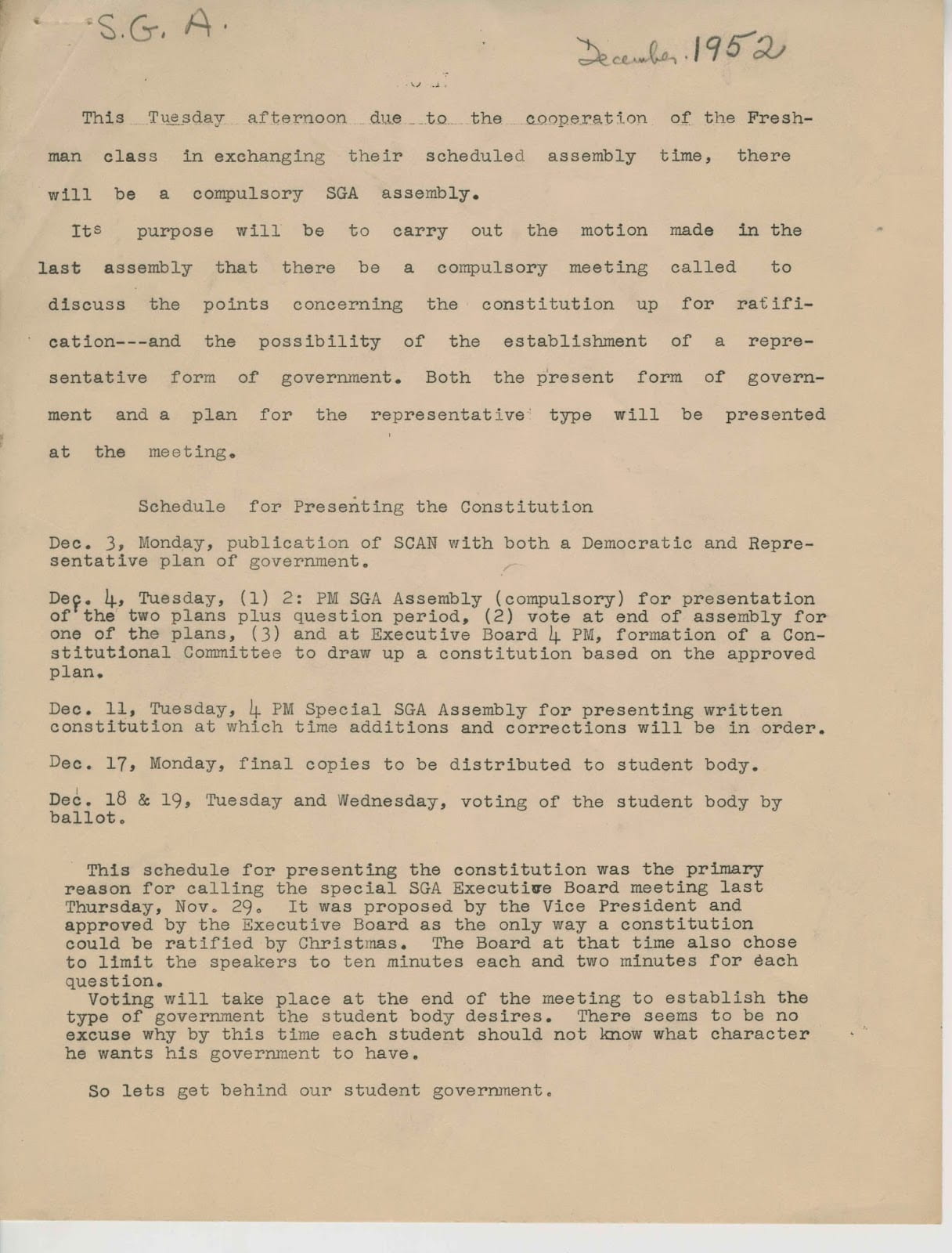

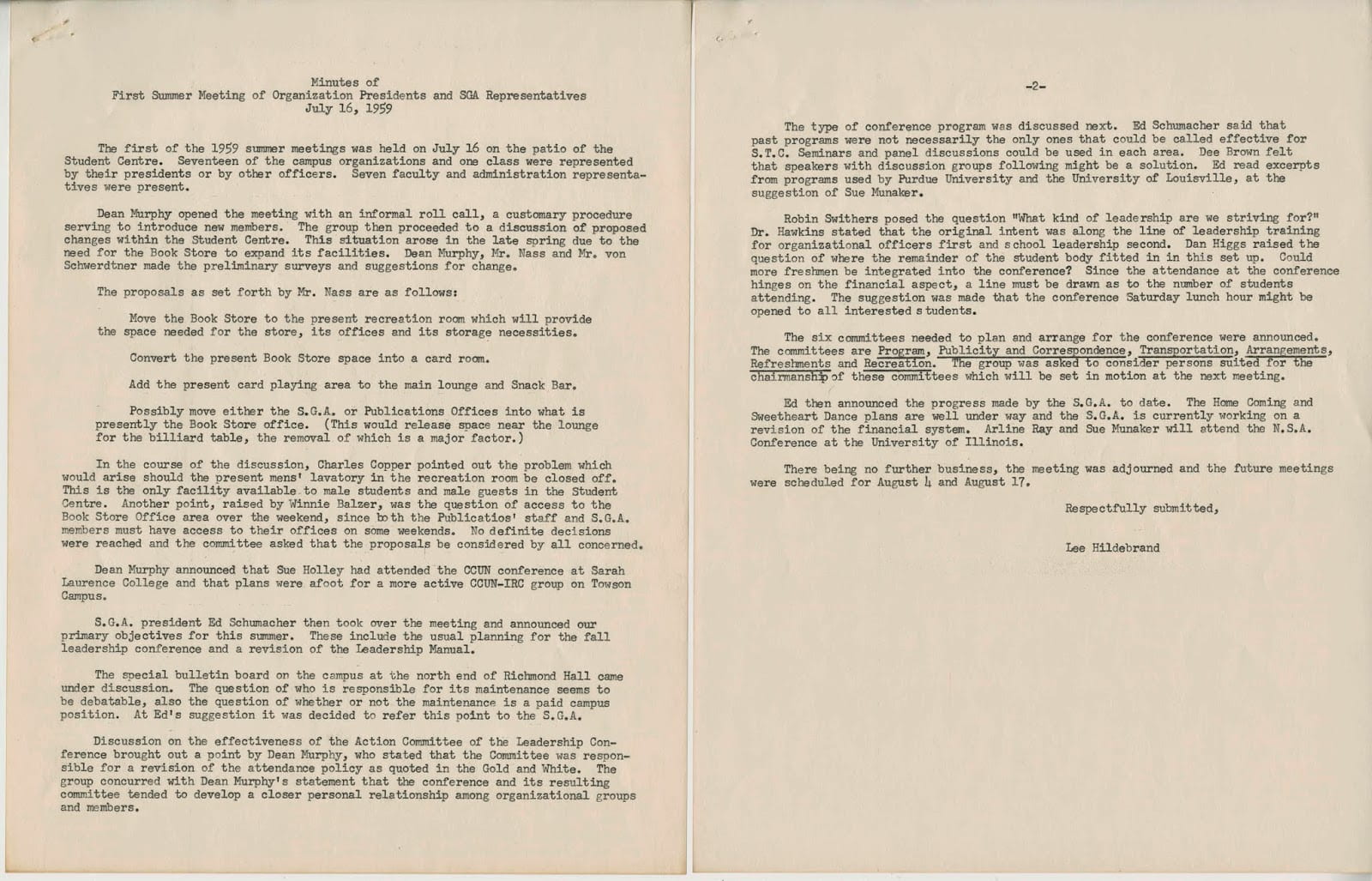

1960s
Students in the 1960s focused on student rights. They contributed to international organizations for Korean orphans and engaged in World United Service (WUS) week. Student interest in national and state issues led them to participate in inter-collegiate bodies of student government representatives, such as the Maryland Association of College Student Governments, United Colleges of Maryland and the NSA Voting age and discount programs through companies such as VISA, then faculty salaries, the conditions of schools, and the right of students to demonstrate became a significant focus. Student resentment of government inaction after a Bowie State College protest continued a contentious relationship between those in academia and Governor Spiro Agnew. Also influencing the SGA at this time were Dr. Martin Luther King Jr., the Vietnam War, and the Selective Service System.





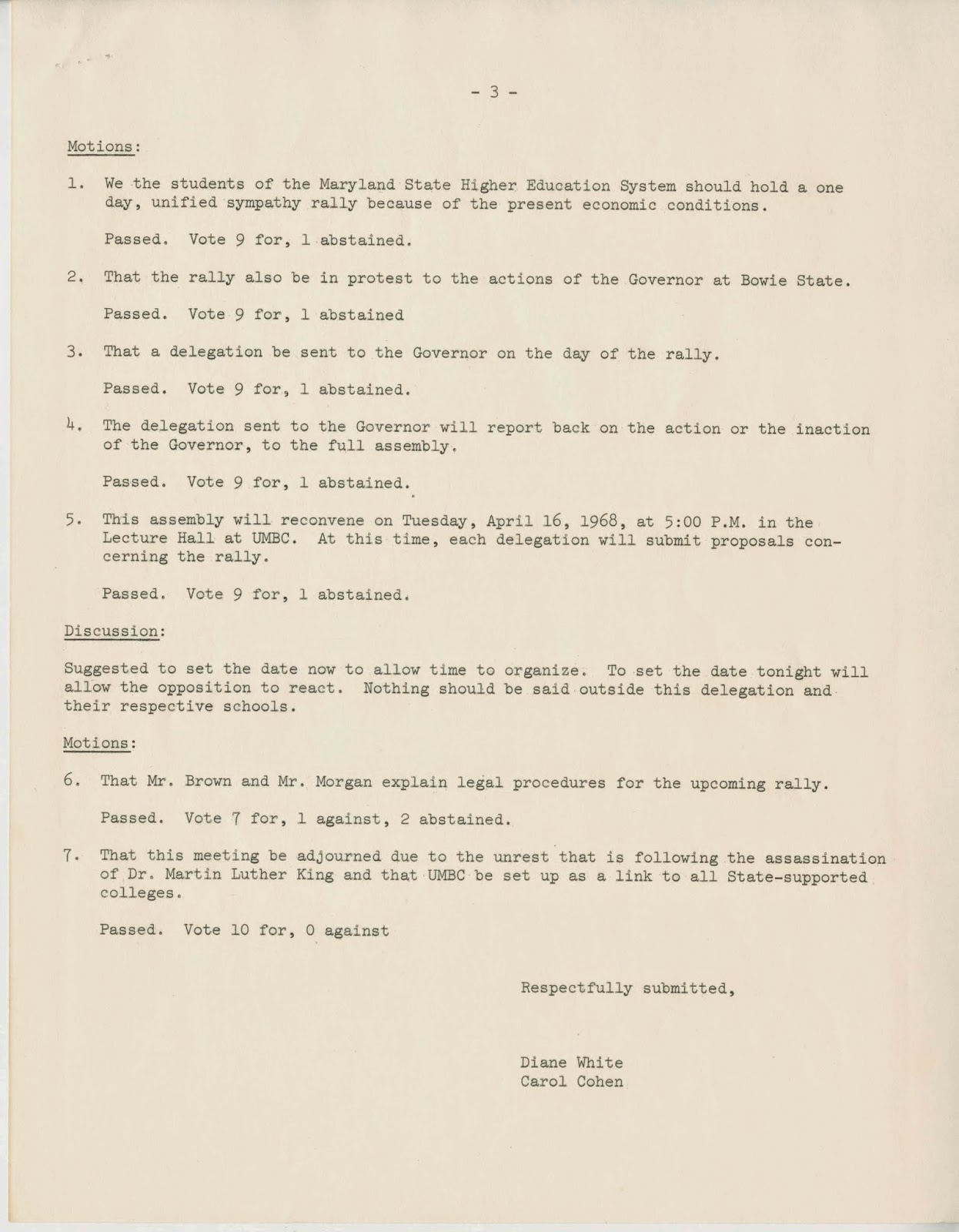

1970s
Political turmoil followed during the 1970s, both external and internal to Towson. The transition from a college to a university caused turbulence. Frustration with the Vietnam War and military recruiting, especially legislation by National Selective Service Director Lewis B. Hershey, and tense relations with the Black Student Union and the Residence Government strained the SGA. In 1970, the SGA established Towson Student Association, Inc. to manage the budgetary procedures and funds. In ’72 an audit was conducted, found $15,000 missing, and arrested a former class president for embezzlement. Despite troubles, the ‘70s also saw the start of the Speaker Series, a powerful program that invited celebrities to speak at Towson; a 1971 mini-grant program to improve instruction by exploring new programs, media, and teaching techniques; and funding for the Student Day Care Center in 1972.
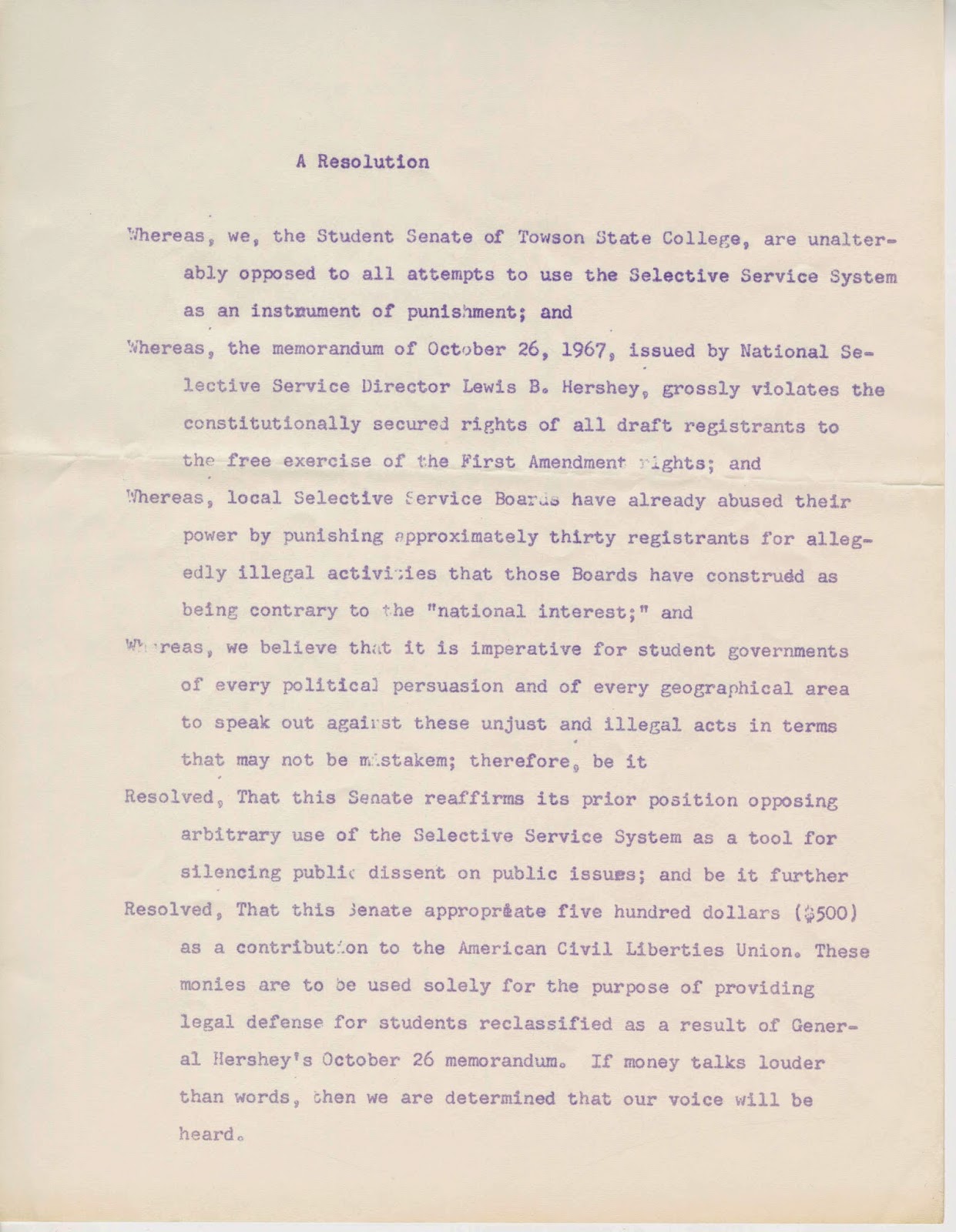
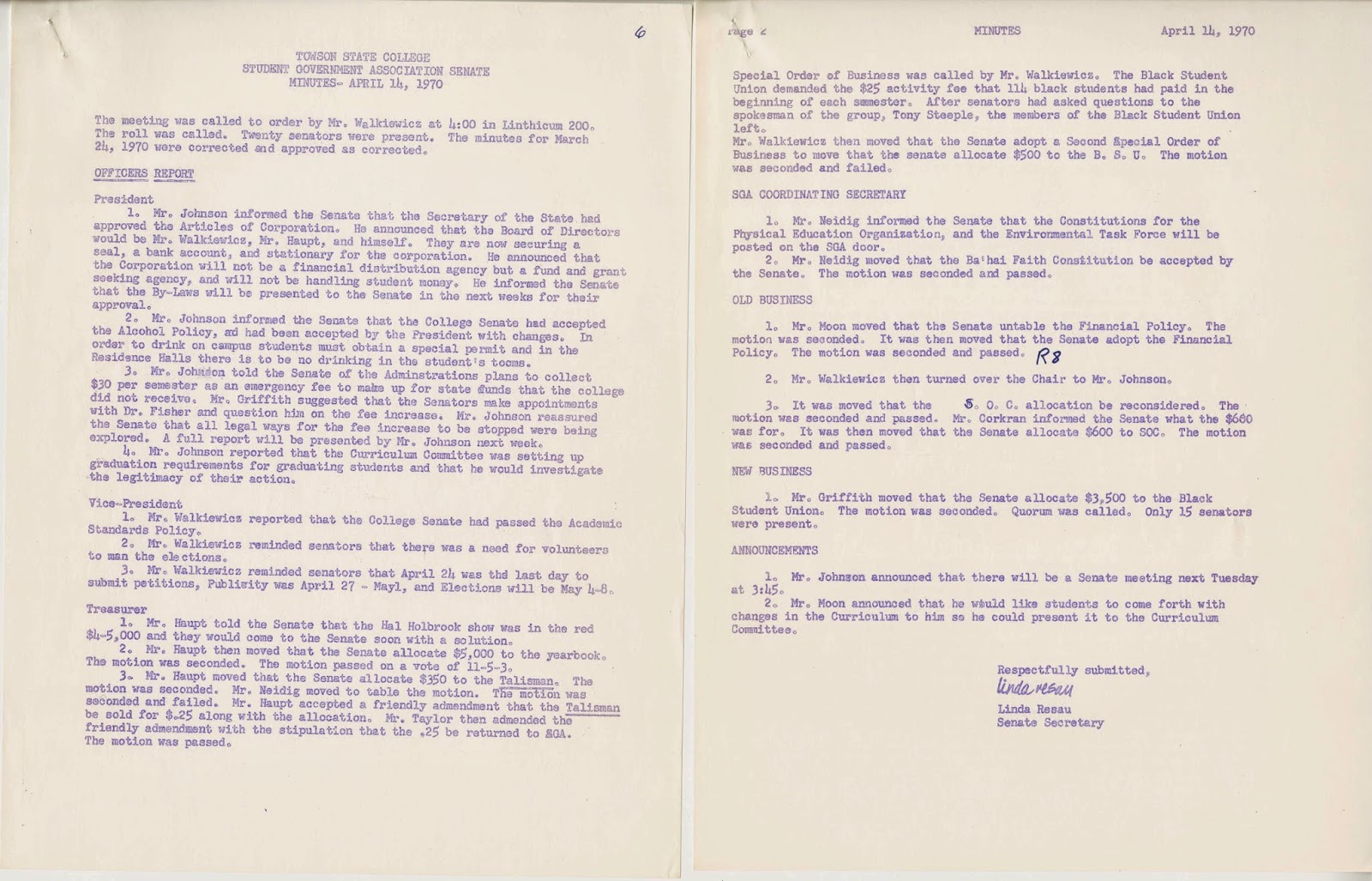

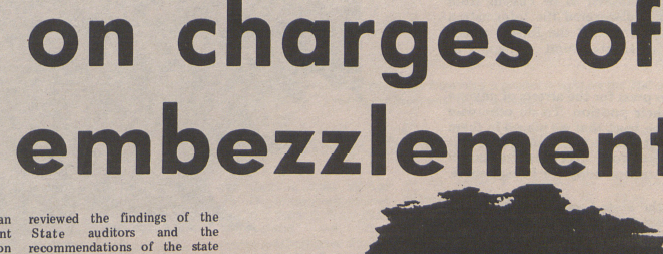
1980s – 2005
Students in the 1980s focused on the Speaker Series, leadership conferences, safe nighttime transportation (referred to as the escort service), constitution approvals for student organizations, and student organization budgets. There was less demonstration but more lobbying; students turned to more internal issues rather than national issues, although national events like the explosion of the Challenger space shuttle clearly affected their consciousness. The responsibilities of the Executive Office included holding programs, advertising events, offering advice for student organizations, and representing students to the University. A priority on publicity and communications influenced the roles and duties of the Executive Board. The Senate managed student fees, recognized and regulated student organizations, validated elections, heard bills and resolutions, and managed the budget. The three Senate committees included Appropriations, Government Operations, and University Affairs. Even with increased focus on communication with the University and Annapolis, students still felt a strained relationship with administration as they navigated budget limitations and University Relations policies.
The latest document in the Student Government Records, a 2005 constitution, outlines an Executive Cabinet consisting of the Academic Affairs Director, Communications Director, Public Affairs Director, Campus Activities Director, Athletics Director, Student Organizations Director, and the On-Campus Affairs Director. The Senate had five Committees: Government Operations, Appropriations, Legislative Action Committee, Public Relations, and Student Life.

Additional Resources:
Alumni Association, State Teachers College. (1941). Seventy-Five Years of Teacher Education. Towson University, Special Collections at the Albert S. Cook Library.
Student Newspaper Collections. (1922-present) Towson University, Special Collections at the Albert S. Cook Library. Retrieved from https://archive.org/details/towsonuniversity and http://library.towson.edu/
